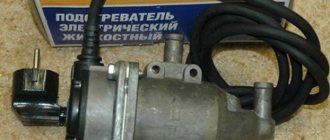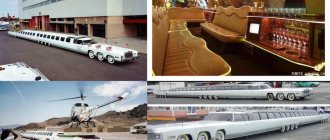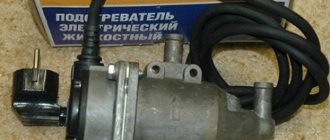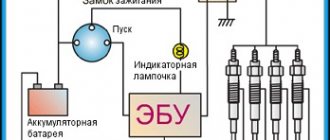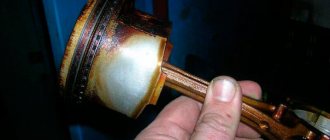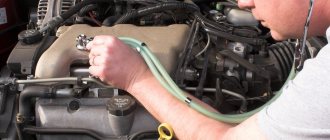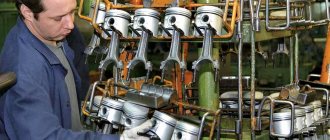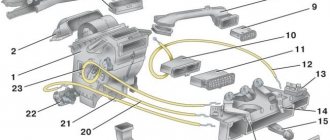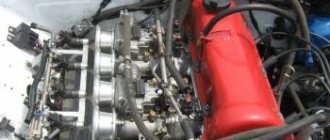Heating the engine in winter can significantly increase comfort when operating the vehicle. Experts also say that preheating provides the opportunity to increase the service life of the motor itself and some units used as attachments.
The engine heater can be installed on different types of internal combustion engines (gasoline and diesel). Today there are several types of such heaters, among which are autonomous (Webasto type) and electric 220V engine heaters. It should be noted that each type has its own advantages and disadvantages. Moreover, in some cases, heating a 220V engine is the optimal solution. Let's look at this type of heaters in more detail.
Engine heaters
Pre-starting mechanisms for heating the engine are divided into two groups:
- stationary (gasoline or diesel) – work autonomously, independently;
- dependent - devices do not work independently, but only from a 220V electrical network.
Example of heating equipment
Electric heaters are produced 12V or 24V.
Electrical (dependent) heating of the engine is called a boiler (heating element - tubular electric heater), which heats the cooled antifreeze to a given temperature and passes through the cooling system of the car’s engine.
Subsequently, as soon as the antifreeze has heated up to the required temperature, the equipment automatically turns off and the heating element stops heating the antifreeze.
Electric heaters for starting are installed on the radiator. This mechanism regulates the correct operation of the cooling system. Structurally, the unit has the following device:
- directly the one-piece, non-separable boiler itself - gas supply, combustion cavity, water tubes;
- burner – with two cylinders;
- pumping system – electric fan, fuel and water pumps;
- control panel (panel);
- block - electric heater of petroleum products, nozzles, electromagnetic valve, fitting for air release.
The heating unit is part of the car engine cooling module. The coolant flows through tubes into the boiler cavity, where it is divided into two streams. One of them is directed through the fuel combustion chamber and gas supply pipes. Cooling antifreeze goes inside the surface of the water jacket.
Another stream washes through the outer water jacket of the pipes.
Both flows of cooling medium are connected in the device housing. Next, from the starting pipe it enters the vehicle engine.
Unit
preheater
If you have a financial opportunity, bet without hesitation. in cold weather it helps to start without torturing the engine, and you can also warm up the interior. Regarding the battery, yes, it is powered by the battery, but you can say it smells (40W), as well as diesel fuel (about 0.4 l/hour). You just need to keep an eye on the battery, and the Duster’s battery capacity is sufficient; if you want to keep the battery longer, buy a heated thermal case. At my work, we are already installing heaters on our second car (diesel) (Gazelle and KIA Bongo). babble in winter. The guys also brought the exhaust to the crankcase of the internal combustion engine (both antifreeze and oil are heated). We usually set the time for 30 minutes; in cold weather it heats up to about 50 degrees. for control: you can install an inexpensive standard remote control (timer) (about 3 thousand rubles), and if you have a smart electrician, you can do it without a remote control from the alarm key fob at all (using an additional channel).
My diesel MB-Vito 2004 has a pre-heater + interior heater. Cool stuff. Set by default at the factory. When I was in Lvov at the end of January (the frosts had just begun) I felt all the charm.
Last edited by Vintik77; 02/20/2012 at 23:56.
If you install Webasto, all your keys remain in place and in order. This is a completely autonomous system; it warms up the engine without starting it.
I do not agree with this statement. It may start, but not without problems. Not a single cold start goes unnoticed on the engine, no matter diesel, gasoline, or gas. Maximum wear on the engine occurs in the first seconds of startup, because all the oil ran off the hot parts just yesterday. and the pre-heater eliminates cold starts, and after just a second of rotation of the starter, warm oil rushes through all the engine channels. and besides, the interior is warmed up, the windows are thawed, BEAUTY. I don’t know how it is in Kokhtla-Jarve, but here in Kuzbass it’s minus from September to April, and in winter it gets down to -55. We are far from the north. Tomsk, Tyumen, Krasnoyarsk and Irkutsk, I think, will agree with me (I’ll keep quiet about Anadyr). I have an old Toyota Corolla 2000. Hydronic is in its third year. the battery is not drained. charge it at least once a month and everything is fine. Once I get Duska, I’ll definitely install the PPP (Pre-Start Heater), probably again. Hydronic. It is slightly cheaper than Webasto. I’m not considering Teplostar - I don’t trust Rossavtoprom
Operating principle
The operation of an electric antifreeze heater is based on a heating element. It heats antifreeze from a battery or 220V power supply.
The principle of operation of the boiler is to connect to a 220V electrical network, as a result of which the substance in the body heats up. Heating the temperature of the liquid, in turn, increases the pressure. The valve closes the supply suction pipe; when heated, the liquid enters the outlet pipe. When the pressure in the engine decreases, the valve opens and allows the product to enter it through the inlet pipe.
Thus, the effect of targeted thermosiphon circulation from the heater to the cooling system appears. The thermal regulator automatically regulates the liquid temperature, which completely eliminates the risk of boiler overheating.
Recommendations for choosing a boiler
To figure out which 220V boiler to choose from the entire variety of models on the market, it is important to consider the following factors:
- boiler from 220V with a specialized coating;
- a boiler without boiling points to prevent deposits from forming;
- a cheap boiler does not fit well with the aggressive antifreeze environment.
The boiler is manufactured with the following power gradations:
- 1.5 kW – for a 16kl engine;
- 1.0 kW – for an 8kL engine;
- 0.5 kW – for use when parked for regular engine heating.
A good example
The period for heating is selected individually, experimenting and choosing. Decisive factors:
- type of engine;
- boiler rated power;
- ambient air temperature.
Now boilers are made of square-shaped plastic.
On average, the boiler heats up for 40-60 minutes. In this case, it is important that the engine is hot, but the liquid does not boil.
You need to buy a boiler only from trusted commercial manufacturers of this type of product.
You can purchase the boiler on the manufacturer’s websites, in specialized retail outlets or at the car market.
Due to the wide range and many models, the device is selected for cars, trucks, and SUVs.
Types of Longfey models
The engine heater is divided into several series. Each model that is included in the series has certain operating characteristics.
You should pay special attention to the engine heater models, as each model has its own unique characteristics
The manufacturer offers the following series:
- Little Q features a square shape that contains parallel placement of taps. Power can range from 1.5 to 2 kW. The pump has a total output of 8 l/mil. Such an electric heater can be embedded into the smallest cooling circle.
- Little Dragon - these electric heaters have a rectangular shape, the leads are located perpendicularly. There are 3 models in the series, which in their efficiency and power practically replace previous devices.
- Decepticon are high power heaters that have a rectangular shape. Available for 2, 2.5 and 3 kW. The terminals are perpendicular. But as for the pump power, it is the same - 8 l/min.
- King - this series contains only a single 3 kW model. This heater has a rectangular shape, the terminals are perpendicular. The electric pump operates with a power of 8 l/min. It can also be installed in a small circle of the system.
- Brothers - This series also contains only one 3 kW model. The shape of the device resembles a barrel. The leads are perpendicular, the pump operates at 8 l/min.
Basically, all devices in the series differ only in heater power and housing type.
Boiler installation
The boiler is installed in a special engine section. In earlier cars such a place is not provided.
Manufacturers of pre-heater instructions regulate the process and layout of its installation. The installation procedure is simple; you can do it yourself. What is needed for this:
- buy antifreeze;
- pit;
- two hours time.
Depending on the manufacturing company, the installation scheme has several variations. Installation is performed:
- with installation in a block - installation complexity, but greater efficiency of the device;
- as a separate device - at the lowest point of the system for cooling, it cuts into the ring of a small circle.
Model equipped with pump
Visual diagram of the boiler installation:
- an electric heater is mounted to the cylinders using special brackets;
- remove the automatic temperature sensor;
- connect the fitting;
- screw the temperature sensor into the fitting;
- remove the drain plug;
- screw in the outlet for the antifreeze supply hose;
- clamps are placed on both hoses.
The installation diagram also contains an option in which the output from the heater is into a tee. To do this, cut the upper radiator pipe. Then the coolant goes into the block to exit into the boiler. In this case, the head will become very hot and the block will be warm.
Sometimes the opposite connection method is used, in which the output from the heater goes into the block. The coolant is hot, has a lower density, and it is easier for it to pass into the cross-section of the adapter. With this option, the block will heat up too much, unlike the head, and when the engine starts, its operating temperature does not drop.
DIY engine preheater
Is it possible to make an engine preheater with your own hands? The video below shows just one of these homemade products.
The fact that many do not want to spend money on installing electric engine heating and intend to do it themselves is not surprising. Russia has never complained about the lack of self-taught inventors, so there are many examples of such crafts.
Homemade heaters are made from various materials. Most often at home they try to warm up the engine with the following devices:
- based on a blowtorch;
- made of tungsten spiral;
- from wire and other improvised means.
All homemade engine heaters have two big drawbacks: they are a fire hazard (there are many cases where cars and garages caught fire due to such devices) and their low efficiency. So it’s better not to skimp on buying a high-quality preheater.
Installation diagram
For this type of model of pre-start electric heaters, in accordance with the location of the thermostat and the drain hole on the motor, one of the types of installation diagrams is used:
- progressive method;
- parallel method.
The parallel method does not involve using the lower of the coolant circulation speeds depending on the resistance of the heater itself. The scheme is effectively implemented by several solutions.
Thermal sensor on the top pipe, there is no tap for draining:
- selection and injection of antifreeze from the return pipe through the trigeminal disk;
- removal of coolant from the lower radiator hose and injection into the heater tube;
- selection from the return pipe, injection through the tee into the upper pipe.
Mounted model from 12V network
Thermal sensor is on the lower element, there is a drain tap on the block:
- selection of the product from the drain valve through the fitting, injection into the engine block;
- selection from the lower radiator tube, injection into the block;
- selection from the block, injection into the upper pipe through the trigeminal element.
Installation progress:
- determine the supply and extraction hoses according to the instructions;
- choose a location and calculate the distance for both hoses;
- drain the coolant;
- remove the tubes going to the stove;
- install ready-made hoses;
- the heater is fixed to the free edges of the hoses;
- fill the cavity with antifreeze.
It is recommended to ensure that the system is completely filled with liquid. If there are air jams, the heater is at risk of serious damage. To fill completely, you need to wait a certain period. The stove tap is open during operation, the temperature regulator is set to the maximum permissible value.
Heaters "Lunfey". Design Features
The manufacturer offers a choice of several device models with different performance indicators. This allows you to choose a heater for almost any car - from a city runabout to an SUV or truck. Despite the fact that there are several types of devices, the heaters are built according to the same principle - they are all tank type with forced circulation of coolant, although they look different in appearance.
The device of the Longfey heater implies the presence of:
- Heating element (operating from a 220 V network);
- Electric pump;
- Composite body;
- Thermostat;
The heater is electric, but it works with liquid. To prevent contact of electrical appliances with antifreeze, this type of housing is used. It consists of two halves separated by a partition. The cavity through which the antifreeze passes is completely isolated from the one in which the electrical elements are placed. But at the same time, the heating element and the pump impeller go into it. The liquid enters the heating tank through the terminals (supply and discharge) located on the housing cover.
Some aspects and nuances
When using preheating, it is recommended to take into account the following points:
- a switch with a timer will ensure engine heating in the mode that the vehicle owner needs;
- the engine is started with the clutch depressed;
- I do not lay the 220V wire through high-voltage supports on the road;
- If the boiler power is higher than 1.0 kW, you should not leave it on overnight.
Compliance with these rules will protect you from fines from the fire inspection and unpleasant situations.
Luxury equipment
Main advantages and disadvantages
Advantages of heating elements:
- use in any climate zone;
- low cost;
- not a complex design;
- simple diagram;
- easy installation;
- saving fuel consumption;
- reliability;
- high degree of security;
- durability;
- the battery does not lose charge;
- recharging the battery;
- ease of maintenance;
- after warming up, the starter load decreases;
- wear of parts is reduced;
- additional features will allow you to preheat the interior and eliminate icing of the windows.
The only disadvantage of such boilers is their dependence on the electrical network.
Starter Heater Maintenance
Installing a heating unit requires regular maintenance. The following actions are necessary during operation:
- checking the spray - to do this, turn on the heater;
- carefully inspect the entire surface of the heater;
- blowing holes - in the cavity of the nozzle and the entire body;
- checking the correct tightening of bolts, fastening nuts and the pump;
- disassembling the nozzle and cleaning its parts in petroleum products;
- cleaning equipment;
- flushing the burner and glow plugs;
- washing valve filters;
- cleaning fuel pump pipes.
Heating equipment simplifies the use of a vehicle and extends the service life of the engine. The acquisition is justified.
Types of heaters 12V and 24V
For travelers and long trips for cargo transportation, it is acceptable, and sometimes simply irreplaceable, not a stationary one, but a vehicle network in the cabin - electric heaters, powered from the mains, or autonomous (on-board):
- electric heaters (dependent) - equipment with modules with a timer and a fan, mechanisms for recharging the battery;
- autonomous heaters - mounted under the hood and connected to the car.
Installation option
An autonomous 12V or 24V heater is installed only in the power supply system or also in the cooling system. The advantages of this type are installation where it is best for the motorist. During production they are not built into the vehicle.
Autonomous devices are equipped and equipped with a remote control. Modern models are controlled from mobile communication devices. The latest models are controlled from a fairly significant distance using GSM (control via auto electronics). This is for devices that operate on 12V and 24V. It is possible to use smartphones and a number of different devices for these tasks, which is undoubtedly a huge plus in favor of convenience when using such a device.
Advantages of 12V and 24V units:
- mobility, no dependence on the 220V electrical network;
- multifunctionality;
- the cooled liquid maintains the set temperature for two to three days.
The disadvantages include:
- discharges the battery;
- high price;
- quite difficult to connect to the car network;
- installation of a battery with a more powerful potential.
Both types of heaters are installed independently or in automobile service centers.
Positive and negative sides
The device has both pros and cons.
The positive aspects of Longfey heaters include:
- small sizes;
- the presence of a pump helps to evenly warm up the antifreeze in the system, while using forced circulation;
- as soon as the system heats up to the required temperature, the heater turns off;
- The range of models is wide, which will help you choose a device for absolutely every car;
- Connecting such a heater will not be difficult, so there will be no need to redo the motor.
Despite all the positive aspects, there are still disadvantages:
- To connect the device, you must have a 220 V socket; if the car is located far from home, you will not be able to use the device;
- it is necessary to follow safety rules during operation;
- the breakdown can only be detected when the car is started.
Thermos type analogues
Thermos devices keep the set operating temperature for two days. The principle of operation is that the heater burns fuel (gasoline or diesel), which is taken from the system to heat the engine. Antifreeze is pumped around a larger circle and passes into a stationary radiator. The radiator heats the air masses, the heated flow of which is directed into the car interior. Thus, both the inside of the vehicle itself and its cooling system are heated.
Heater from 24V network
Advantages:
- reliability;
- no need for additional nutrition;
- ease of connection;
- low power.
The coolant circulates only due to the temperature difference (under pressure). When it has warmed up in the heating housing, it then moves along a small cooling circle.
This process takes from 10 to 20 minutes, depending on the ambient temperature. The device consumes 450-550 ml of fuel per hour. For comparison, electric counterparts consume about 40W of electrical energy over the same period of time.
Making homemade heating
A factory-made boiler or heater is more practical and safer than one made on your own. Although the option with a homemade device also has a right to exist.
It is important to remember that when independently producing a device for heating an engine, exercise the utmost possible caution during subsequent operation. This is especially true for fire safety.
There are many options for DIYers. One example:
- in the side panel and in the bottom of the weapon casing, saw a hole for cutting a thread for a candle;
- the sleeve is connected to the suction pipe;
- installing the structure directly into the tank of the car;
- supply of on-board network cables.
The peculiarity of this installation method is that it is used to heat not the engine, but the fuel.
To avoid damage, this type of heating can be used after the engine is turned off.
Fuel filter heater for diesel engine separator configuration
To manufacture a fuel filter heater for a separator configuration of a diesel engine, you will need a lathe.
Before installation, it should also be taken into account that the drain unit in diesel engines is used to remove liquid from the sump. Accordingly, if this device is to be removed, it is necessary to use only proven high-quality fuel.
What will you need?
Tools and materials required for installation:
- set of wrenches;
- a piece of metal pipe for making a bushing;
- wires for connection;
- a lathe that will be used to cut threads.
Algorithm of actions
You can install a diesel fuel filter heater of a separator configuration as follows:
- A metal sleeve of the required size is made. The outer circuit of the device must match the drain valve of the system.
- Using a drill, drill a central hole.
- Internal and external threads are cut. The outer pitch should correspond to the drain element, and the inner pitch should correspond to the thread for the glow plugs.
- The completed structure is assembled from candles. The resulting mechanism is screwed into the body of the separator device. The shape of the part itself needs to be corrected - a pin should be made on the hexagon. To do this, a screw or bolt is welded on the side.
- After installation, the wiring is laid. On the positive line you need to install a switch button and a four-pin relay. The entire electrical circuit must be protected by a safety device to prevent voltage surges and short circuits.
- After installation, it remains to connect two terminals. Grounding or “ground” goes to the bushing, and the positive contact must be connected to the glow plug. The installed device is being tested.
Video: features of the use of fuel heaters
Roman Romanov in his video spoke about the nuances of using heating devices for fuel filters of separator design.

